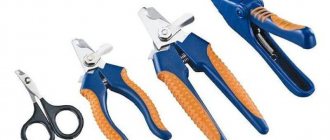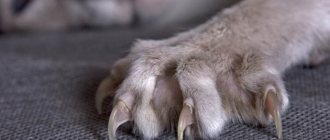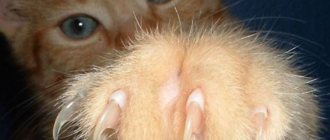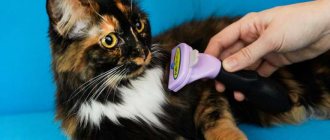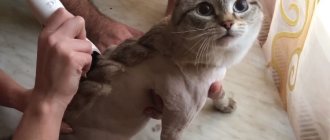Once you have a cat in your home, it brings with it the attendant dilemmas regarding nail care. The most significant problem for cat owners is torn wallpaper, sofas, beds, all kinds of carpets and cabinets, and endless scratches when trying to play with their pet.
This article details how to accurately trim an animal's nails at home without causing harm to yourself or your furry friend. At what age can you trim a kitten’s nails and how to choose the right clipping tool.
Why do you need to trim your nails?
Under natural conditions, claws are constantly ground down on hard soil, tree bark, during hunting and games. But living in comfort and safety, pets show less activity, and scratching posts are among the available means for shortening manicures. Some pets simply ignore scratching posts and unknowingly doom themselves to constant discomfort.
There is another category of cats that definitely need to trim their sharp claws - these are overly aggressive pets, especially towards children, who love to scratch their legs and arms. Although in this case it is better to use silicone anti-scratch pads, because the sharp and uneven edges of a recently trimmed claw can cause unpleasant scratches.
When is the best time to trim nails?
For such an important procedure, you need to use the right moment - when the cat is sleepy or simply calm. If your pet clearly expresses its dissatisfaction - it bites, breaks out, scratches, then you need to calm it down by stroking it. Be sure to praise the cat, even the naughty one.
There are harmful cats and cats that do not get used to the process of cutting their claws, no matter how hard you try. In this case, you can wrap the pest in a blanket and pull out each paw one by one.
The main thing is for the pet to understand that there is nothing terrible in the procedure, and at the end he can receive some pleasant bonus in the form of a treat. If you start cutting nails without reassuring your pet, you risk seriously damaging his trust in you.
To develop loyalty to the procedure, we recommend starting to trim kittens’ claws from 3-4 months of age, when the baby becomes more active and playful. The emergence of a useful habit at an early age eliminates most of the difficulties in this matter.
Here's what not to do:
- Scolding and screaming will cause even more fear in your pet, and it will be extremely difficult to trim claws in the future.
- Trying to catch a cat around the house while playing - the cat will respond to this with aggression, misunderstanding and indignation.
- “Break” a cat by force – you shouldn’t hurt it by trying to get your way.
Preparing for your first haircut
Trimming nails should become a familiar procedure for your pet from an early age. You should periodically pick up the kitten in your arms and, pressing slightly on the pads of its paws, allow it to release its claws, while simultaneously massaging its paws. Over time, when the kitten begins to calmly respond to manipulation, it will be useful to reward it with treats, thereby reinforcing the positive habit.
IMPORTANT: a kitten should have its claws trimmed when it is 2 months old.
Ideally, the pet should be indifferent to the procedure
The procedure can only be carried out when the animal is in a completely calm state. It is strictly forbidden to use physical force and raise your voice at your pet, but it is still necessary to show persistence: there is a chance that the pet will begin to worry and break out.
Talk affectionately, pet and treat your pet, and enlist the help of someone who can hold the animal. Do not insist on the procedure if the cat screams loudly and breaks out, this is fraught with psychological trauma and severe stress. Be patient if you want to make bone trimming a habit in your pet's life.
How often should you trim your nails?
The number of procedures for cutting claws varies, and this is not surprising - the characteristics of each cat’s body are individual. For one cat, it is enough to trim its claws once a month; for another, the treatment will need to be repeated three or even four times. Be guided as the claws grow. If the cat is accustomed to a scratching post, then she will naturally partially grind off her claws, which will prolong the effect of trimming. And if you haven’t managed to develop such a useful habit yet, you can read our effective tips for teaching a scratching post.
As a rule, the more often you trim your nails, the better, even if you trim just a little at a time. By trimming its claws too infrequently and with slow growth, the cat will have time to wean itself off the necessary procedure, and you will have to retrain it.
Claw care is especially important for cats attending exhibitions. For them, cutting nails is not only a hygienic procedure, but also a cosmetic one, since all exhibition animals must not only be healthy, but also look impeccable.
What you need to trim nails
To cut cat claws, you need to choose the tool that is most convenient for you, so that it removes excess quickly and painlessly for your pet. You can buy several types of tools to understand exactly which one you intend to use in the future. Since the cat has as many as 18 toes, you can try each type in action.
There are several variations of devices:
- Nail Scissors – The scissors you use to trim your nails should only be used on your teenage kitten's delicate claws. For an adult cat, it is better to have a separate tool, designed taking into account the anatomy of the claw structure.
- Manicure tongs are convenient for removing the tips of claws.
- Blister nail clipper (specialized scissors designed for cats) is an affordable tool that is easy to use.
- Guillon trimmer - this tool can cope with thick claws of the hind paws, the disadvantage of using it is that it is difficult to see which part of the claw will be cut off.
You can choose what is more convenient for you to work with, however, it is preferable to use a blister or guillotine trimmer, because these tools are specially selected for a thick cat's claw.
Additionally, for comfortable nail trimming you may need:
- a piece of cotton wool or a cotton pad;
- hydrogen peroxide;
- hard manicure file;
- a machine for cutting hair (if the cat is too fluffy, this will help remove the hair between the fingers).
Useful video
Video on how to properly trim a cat's claws:
If you accidentally cut the living part of the claw or the skin on the pad, then the main thing here is not to panic. If there is a small amount of blood coming out, just gently treat the bleeding claw or wound with hydrogen peroxide and calm the offended pet.
If, without keeping an eye on your pet, he jerks unsuccessfully and the bleeding from the wound is abnormally strong, immediately cover the cut with a clean piece of tissue and take the cat to the veterinarian.
How to trim a cat’s claws: getting ready and carrying out the procedure correctly
Inexperienced owners think that trimming a cat’s claws is a difficult and unnecessary task. There may be some justice in this approach, but a responsible owner must have certain skills, and painless nail trimming is one of them.
Do cats need manicures?
Nobody cuts the claws of wild cats, but in (civilized) zoos even lions get a manicure, and the claws are not only trimmed, but also filed. This procedure is mandatory and is explained by a number of reasons. Cats' claws grow constantly, that is, if they are not worn down or trimmed, then problems cannot be avoided.
Another argument emphasizing the uselessness of the procedure: in villages and cities, many cats live without manicure and maintain their claws in order on their own. Yes, it's true, most animals know how and enjoy caring for their claws. A cat's daily diet includes cleaning and sharpening its claws.
Cats whose skills have been dulled need meticulous care. For the most part, this applies to artificially bred breeds. Some animals have a genetic predisposition to rapid growth of claws, that is, the cat simply does not have time to wash them, even though she leads an active lifestyle.
Let’s make a reservation right away: if you trim a cat’s claws correctly, there is nothing dangerous or painful in this procedure. Moreover, many pets need (!) their nails trimmed to prevent ingrown nails. Claws that are too long bend, and their tips become like sharp hooks. The cat knows how to retract its claws, but to a certain length, and if these hooks look out of the sinuses, they cling to upholstered furniture, the owner’s clothes and carpeting. Tights and marks are not so bad, the main thing is that the pet experiences discomfort, walks unsteadily, and if he pulls his paw too hard, he risks injuring his finger.
If you notice that your cat has begun to dig at the floors and walls (usually at night), this is a clear sign that her nails are too long.
Unlike some dogs, all mustachioed tabby dogs have fifth toes on their front paws. These fingers are mobile and functional, and the claws on them serve as an additional tool. The claw on the fifth toe does not wear down naturally. In most outbred cats, the claws on the fifth toe only grow to a certain length, but there are exceptions. A claw that is too long curls toward the paw, pricks and pierces the skin. It is easy to imagine how quickly a wound will become infected.
Conclusion: whether your cat personally needs a manicure is up to you to decide, but according to general rules, nail trimming is a mandatory grooming procedure.
It would be convenient if with each animal the owner was given instructions - what to feed, when to bathe, how to play... in practice, each owner gains skills through trial and error. Based on the experience of owners and veterinarians, we can conclude that the frequency of claw trimming depends on a number of factors, and here are just some of them:
- Lifestyle – a cat that goes outside has the opportunity to actively grind its claws. Lazy couch cats need more frequent manicures.
- Genetics – Some pets are prone to extremely rapid nail growth.
- Balanced diet - if the diet lacks microelements, claws grow more slowly.
- The presence of cat accessories - scratching posts, special rugs and posts with which the cat plays, this is a tool for grinding down the claws.
- Pigmentation - it is believed that light claws grow faster than dark ones.
The rate of nail growth for each cat is individual and depends on a number of factors. Shearing is carried out strictly as needed, on average once every 2–4 weeks.
A word of caution - don't trim your pet's nails just for convenience. Unfortunately, some owners often trim their cats' claws out of fear for the integrity of the furniture or injury. It is better to think about material damage before getting a cat, and if you are afraid of serious scratches, you need to raise a pet.
There is an alternative, although not the best, but quite adequate - caps for claws. Silicone caps are attached with glue and serve as a temporary measure, for example, to ensure the safety of a child while meeting a cat.
Tool selection
A professional “with a full hand” can easily trim a cat’s claws with ordinary scissors, but for beginners it is better to use a special nail clipper. The problem is that the structure of a cat's claw is not as simple as that of a dog or a human. The finger and claw are a complex mechanism that includes not only joints and ligaments, but also large blood vessels. Thanks to such a complex device, tailed animals can hide and extend their claws at will.
Without going into the depths of cat anatomy, we can say that the claw consists of two parts: keratinized and living. You can cut only the tip, and if you catch the living part, you will not be able to do without bleeding. In addition, when a living part is injured, large nerve bundles are excited, and the cat experiences severe acute pain. If it happens that the claw was cut too short, the cut should be treated with antibacterial solutions until it is covered with a layer of keratinized tissue.
To carry out the procedure at home, veterinarians recommend using a specialized instrument. The experiences and reviews of owners vary greatly, as everyone chooses a more convenient accessory and approach for themselves. So, if you are going to trim your cat’s claws yourself, you can use:
- Using stationery scissors - as mentioned above, if you are not experienced, there is a high risk of damaging blood vessels.
- Nail clippers are a safer tool, which, although not intended for animals, will allow you to trim and blunt only the tips of the claws. When using tweezers, you need to hold them perpendicular to the claw; if you press at an angle, the nail plate may crack.
- The guillotine is the most suitable tool for a beginner. The full name of the accessory is a guillotine-type trimmer. The advantage is that the claw is trimmed in one motion along a precise line. It is important that the trimmer is of high quality, since cheap accessories quickly become dull.
- Veterinary tongs are a hybrid of manicure tongs and a guillotine; they are convenient because they have handles that fit well in the hand.
- Special scissors (clave clipper) - they look like stationery ones, but at the ends of the blades there is a clip that carefully clasps the tips of the claws.
For the procedure, you need to prepare a first aid kit, at least cotton swabs and a solution to stop bleeding. No one is immune from mistakes, and if the claw is damaged, help must be provided quickly and competently.
In any large pet store you will find many models of accessories, but the mechanism of action for most of them will be similar - guillotine. When choosing such a tool, it is recommended to sharpen the cat’s claws after trimming with a special file or whetstone. If you buy a file in a regular store, choose a dense one, with a fine cross-section, but high rigidity, since cat claws are much harder than human ones.
If you are afraid of hurting your cat, it is better to entrust the first procedure to a veterinarian.
You can take your pet to the clinic or have it groomed at home. In any case, in experienced hands, your cat will get a manicure in literally 3 minutes.
Preparatory activities
Some owners are simply forced to take their cat to the doctor or to a nail trimming salon. The fact is that not every adult purr will allow its claws to be trimmed. On forums people often ask for advice on how to trim a pet’s nails if it breaks out or bites. Hypothetically, there are two options: give the pet a sedative and take advantage of his calmness, or accustom the cat to the procedure. Naturally, the first option is acceptable only if the situation is urgent.
Accustoming a cat to the grooming process should begin from childhood. There is no need to trim your kitten's claws, but it is necessary to familiarize him with the tool and the process itself. Repeat the algorithm when you have a free minute:
- Take the baby in your arms, stroke it and voice your intentions: “Now we’ll trim the claws, don’t be afraid.” Try to speak softly but confidently, don’t worry, your pet will feel it.
- Place your baby on the table and move the tool that you will use to trim his nails in the future. The baby will be interested in the accessory and needs to be encouraged.
- When the kitten sniffs the nail clipper and stops paying attention to it, pick up the kitten's paw.
- Click on the pad to reveal the claw. Touch it with the coterez. Repeat with all fingers and praise the kitten for each calmly accepted touch.
- When the previous point does not cause embarrassment, click the nail clipper next to the claw after making contact. Your baby will probably be scared the first time, but your praise and reassurance will calm him down.
Training an adult cat follows a similar algorithm, but there is some difficulty. A kitten is happy to do any activity together, even something strange, but you need to train an adult cat by adapting to its mood. If your pet is irritated, and you come at her with an incomprehensible clicking thing, she is unlikely to perceive the training process as a positive activity.
The procedure itself is not as complicated as it seems, but it requires attention and caution. Separately, it is necessary to say about cats with dark claws. The richer the pigmentation, the less visible where the living part of the claw begins. Try shining a flashlight on the claw; if that doesn’t help, contact a professional; don’t cut it at random. If you don’t have the opportunity to see a veterinarian, and “you need to do something” with your claws urgently, use a nail file.
Try to keep it clean. At a minimum, wash your hands and sanitize the instrument, even if it has just been taken out of the package. There is no need to treat the claws, but if your cat goes outside, it is advisable to wash its paws. Have clean napkins, sponges and a towel on hand. For the first procedure, we recommend preparing a first aid kit for yourself: sponges, brilliant green, bandage, cotton swabs.
Tip: the cat will be calmer if she understands what is happening, so the claws on the hind legs are cut after the front ones.
Be gentle but confident; your hands should control the cat's movements. If the pet pulls its paw at the wrong moment, the guillotine will hit the air, but if the claw is deeper under the blade, trouble will happen. Both of your hands will be busy, one will have a tool, the other will have a cat's paw, so for the first procedure it is better to enlist someone's help.
When you press on the pad of your finger, the claw is completely exposed. Examine it from the side, so you will accurately mark the border beyond which the vessels are located. The pink, live area contains nerve bundles, so if you accidentally damage the claw, the procedure should be stopped. The cat will be in pain and it will most likely not be possible to trim the remaining claws without harm. Some owners advise cutting all the nails at the beginning, and only then filing them.
Trim only the tips of the claws, that is, you need to leave at least 2 mm of keratinized tissue between the cutting line and the living part of the claw. Immediately after cutting, sharp corners will remain in the place of the cuts, which are rounded off with a sanding file. Run your claw over a napkin with a tenacious structure and ensure that there are no burrs on the claw. Was everything successful? Praise your pet and move on to the next claw. Take it step by step. If the cat becomes nervous, stop the procedure. There is nothing wrong with continuing your haircut the next day, but the negative emotions associated with the procedure are quite difficult to overcome.
The cat needs to be praised after each successfully trimmed claw, even if it twitches, but bites and scratches need to be stopped - that is, stop, straighten the cat and try again.
What to do if your cat is aggressive?
The main problems arise when you need to trim the nails of an aggressive cat. Let us immediately make a reservation that in such a situation there is no place for self-confidence, since an angry pet can cause serious injuries. The first thing you need to do is find an assistant, or better yet two. One person will hold the cat, a second will trim the claws, and a third will manage the emergency first aid kits.
So, we take it as an axiom that a cat needs to trim its claws, even if it doesn’t give in, hisses and bites. A method that has been proven over the years and by thousands of owners involves using a small, durable (sports) bag. The purpose of the bag is that paws can be placed in it, the claws on which are not cut. If you have a strong and dexterous helper, you can wrap the paws in a towel.
Before the procedure, the animal needs to be given half the dose of any veterinary sedative, because our goal is to accustom the cat, and not to cut its claws once and forget about it. Your assistant takes the cat by the skin on the shoulder blades (scuff) with one hand, and with the other holds a bag, towel or fold on the cat's lower back. At this stage, the main thing is not to scare the animal even more, because the pet understands that you are planning something terrible.
Try to act quickly and confidently, but do not forget to talk to the animal. If necessary, divide the procedure into several approaches so that the pet can rest. If the cat loses its temper and starts attacking you, it needs to be isolated in the room for 10–15 minutes, and the procedure should be continued in the veterinarian’s office. It’s mysterious, but true - when a veterinarian trims a pet’s nails, there is practically no resistance. Apparently, the reason is that the animal is in an uncomfortable environment and in the hands of a stranger.
A small fluffy kitten in the house is not only a great joy, but also a huge responsibility, because the pet needs careful care. And, if most cats perceive procedures such as bathing and brushing favorably, then trimming claws turns into a real problem not only for animals, but also for their owners. Let's try to figure out why you need to trim your cat's claws, whether it can be done at home, and what tools are needed for this.
What to do if your cat resists
If your cat won’t let you cut her nails, you can try to accustom her to this procedure gradually, the main thing is to be patient.
Try a few simple tricks:
- If your cat doesn’t have enough patience for a long time, start small. To begin with: cut two claws and release the pet, not forgetting to praise. Then cut off more, and increase the number of toes until you have processed all the paws.
- Wait until the cat has no desire to resist when she has eaten and becomes sleepy.
- Try trimming nails while your cat is sleeping.
- If your cat becomes stressed due to the procedure, you can try giving him sedatives using natural herbs, for example, “Cat Bayun”.
- If you catch a kitten in a playful mood, you should postpone claw trimming until the kitten becomes less agitated.
We hope that our article will help you develop an effective strategy for trimming your pet's nails. If your cat won’t let you get close to his manicure with scissors or has an aggressive character, then we recommend reading our article about silicone anti-scratch pads (harmless to the pet’s body and a solution for responsible owners). Share with us and our readers in the comments: what tricks do you practice when trimming your cats’ claws?
Fingers
For many people, the phrase “cat toes” sounds unusual, but it is completely anatomically justified. Probably the reason for the misconception that cats have claws growing straight from their paws comes from the fact that the cat's toes are hidden under a layer of fur.
The fifth toe on the forelimbs most often remains invisible to the owner
On each cat's paw there are several toes, from which claws already grow. Unlike people, cats have a total of 18 fingers and the same number of claws:
- Cats have five toes on each of their front paws;
- The hind legs are equipped with only four toes.
The different number of fingers is associated with different functions that the hind and forelimbs are endowed with. The hind legs are used primarily as a support, while the front legs are an important defensive and hunting tool. Due to the divergent tasks, the structure of the claw on the front and hind paws is also different. The front claws are sharper, but at the same time brittle. They are more susceptible to delamination. The claws on the hind limbs are replaced less frequently and are more hard.
Polydactyly is common among both humans and animals.
The phenomenon of polydactyly or polydactyly also applies to felines. Exceeding the normal number of toes usually does not prevent cats from living and hunting. The Guinness Book of Records contains information about a record-breaking cat from Ontario with a total of 27 toes.
